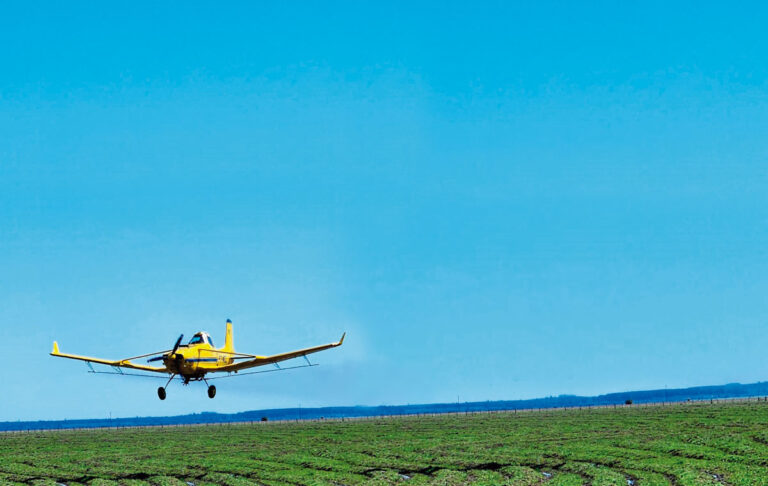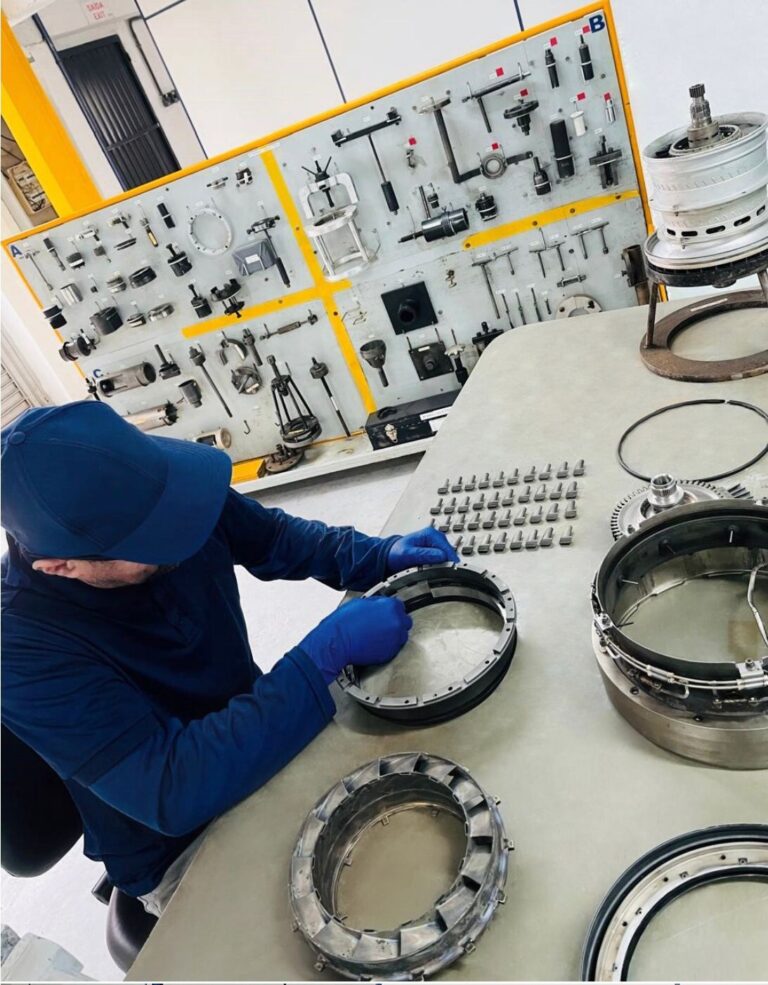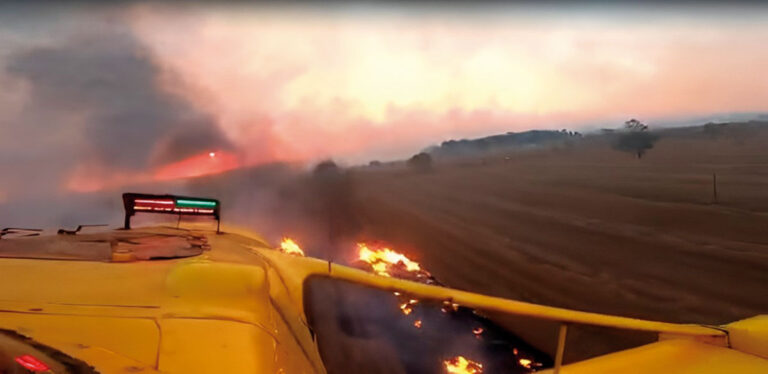What is the appropriate safety buffer to protect the environment and populations from the impact of agricultural inputs? The debate intensified during the process of updating Instruction Normative (IN) No. 2 from Brazil’s Ministry of Agriculture and Livestock (Mapa), dated August 1, 2008, which regulates the use of aerial application in the country. Considering the advanced onboard technology of aircraft and aerial spraying systems, the sector believes it is time to replace rigid parameters—such as a buffer zone of 250 to 500 meters from residences, animals, and environmentally sensitive areas—with application protocols.
“Since the last regulation, application technologies have evolved significantly,” emphasizes agronomist Alan McCracken. According to the aerial spraying expert, the ideal scenario would be the adoption of operation-specific criteria.

Professor Maisa believes that the deposition band study shows that aerial spraying can indeed be controlled.
The strongest support for the aerial application sector comes from academia. The study “Drift and Safety Buffer in Aerial Spraying” (full article in the December 2024 edition), developed by the University of Brasília (UnB) within the Center for Studies on Aerial Agricultural Activities (Neaagri), focuses on the deposition band. According to Dr. Maisa Santos Joaquim, PhD in Forest Sciences and Vice Dean of the School of Agronomy and Veterinary Medicine (FAV) at UnB and President of Neaagri, “Aerial spraying is safe, provided that all the necessary criteria are strictly followed.”

CONTROL
In the deposition band study presented by UnB on November 20, 2024, under ideal application conditions, the maximum drift recorded was 45 meters, and the minimum was 6 meters (see chart on page 14). On average, drift remained within a 20-meter range.
However, Dr. Maisa emphasizes that the research aimed to evaluate the deposition band, not drift itself, which remains the Achilles’ heel of aerial application. Therefore, the next phase of the study will focus specifically on drift. According to Maisa, the tests demonstrated that aerial application is not only controllable but that it is possible to develop an equation to adjust deposition accordingly.
Her reasoning is as follows: “If it is possible to control and monitor the variables that influence aerial spraying in the deposition band study, then it is also possible to control the spraying process to minimize unwanted drift.”
Building on the first phase, the second stage of the study aims to show that exodrift (outside the target area) can be controlled, just as endodrift (within the area, during application) or a homogeneous deposition band can be achieved. “If we obtain sufficient data and conduct a specific drift study, we will be able to predict the extent of that drift and directly influence the definition of the safety buffer for sensitive areas,” says the scientist.
UnB and Ufes Research on Drift May Transform the Future of Aerial Application
“The second phase of the drift-focused study will provide new direction for Brazilian—and possibly global—aerial agriculture.” This statement by Dr. Edney Leandro da Vitória, professor of Agricultural Engineering and coordinator of the Graduate Program in Tropical Agriculture (PPGAT) at the Federal University of Espírito Santo (Ufes), highlights the importance of the project conducted by UnB’s Neaagri center for advancing the sector and breaking down biases against the technology.
According to Edney da Vitória, the most frequently cited drift study dates back to 1998—27 years ago. The studies from 2003 and 2005 are literature reviews, and the most recent ones are case-specific. That is, drift is estimated based on application in a single location. “We propose a drift study in multiple locations, across different states, under varying field operation conditions,” explains the researcher.

Professor Edney da Vitória emphasizes the credibility brought by the partnership between UnB and Ufes, two renowned federal universities.
To this end, Edney da Vitória, who also serves on the scientific council of the Agricultural Aviation Scientific Congress (Sindag/Ibravag), was invited by Neaagri’s president, Maisa Joaquim, to join the research team.
As in the first phase, the project will include Professor Álvaro Nogueira de Souza (PhD in Forest Engineering and research coordinator), and Professor Éder Pereira Miguel (PhD in Forest Engineering, specializing in pure statistics), who will assist in data analysis.
“The data collection methodology is also our own,” notes Edney da Vitória. Unlike the deposition band study, where data was gathered by specialized companies conducting technical audits in the field, the new phase will involve training teams to perform measurements during actual applications in every Brazilian state with aerial agriculture activity, across varying conditions.
This approach increases the number of variables, ranging from aircraft model to droplet size, aircraft altitude, wind speed, and direction.
LEARN MORE
In the “Drift and Safety Buffer in Aerial Spraying” study, the methodology used to analyze deposition also measures what extends beyond the target area, in order to determine how much product overshot its intended zone.
The product that landed outside the deposition band was considered drift in the study, as it reached areas where application was not intended.
In the second phase of the research, drift will be studied based on the variables that impact aerial applications.
The two types of drift that affect aerial spraying are endodrift and exodrift. Endodrift is considered beneficial because, during the aircraft’s next pass, the application is completed. This is the desired drift. On the other hand, drift outside the target area—exodrift—is the one the study aims to demonstrate as controllable. The statistical hypothesis is that the buffer zone can be reduced. Using the statistical methodology from the deposition band study, the researchers will determine how much product reaches areas outside the target zone—where the aircraft did not fly over.
WHAT IN 02/2008 STATES

I – Aerial application of pesticides is not permitted in areas located at a minimum distance of:
a) 500 meters from populated areas, cities, towns, neighborhoods, or from water sources used for public supply;
b) 250 meters from water sources, isolated dwellings, and groups of animals;

REVIEWING EXCLUSION ZONES MUST INCLUDE SOCIAL RESPONSIBILITY
For Cláudio Júnior Oliveira, Operational Director of Sindag and economist, any analysis of exclusion zones must consider not only environmental factors, but also social responsibility. “Removing planting areas, even small ones, directly affects the production of food, furniture, biofuels, paper, computer components, and even medicine,” emphasizes the manager, who has been closely following the updates to IN-02/2008, which is set to become an official ordinance.
The modernization of operational regulations in aerial agriculture is aligned with Decree 86.765/81, which regulates Legislative Decree 917, dated October 7, 1969, the law that formalized aerial application activities in Brazil. The public consultation closed on January 31 of this year, with 989 contributions submitted through the Normative Acts Monitoring System (Sisman). Among the proposals is the revision of the exclusion area.
As these contributions are now being reviewed, Oliveira emphasizes that the economic impact of the exclusion zone must also be considered. “It doesn’t only affect thousands of families working in aerial agriculture—it impacts everyone involved in that crop’s production chain, generating unemployment and significant economic losses for cities and families.”

Cláudio Júnior Oliveira states that unnecessary safety buffers negatively impact the production of food and other essential items derived from agriculture.
IMPACT
Following this reasoning, agricultural pilot and Sindag board member Alexandre Schramm argues that the buffer zone negatively impacts aerial service providers. He states that, in many cases, operators are unable to close major contracts because they must leave portions of land untreated due to regulatory restrictions. “Some growers prefer to have the entire field sprayed either by aircraft or ground equipment—they don’t like to mix solutions,” he explains.
Schramm points out that this issue also affects agricultural production costs. Given the agility and embedded technology of aerial application, he highlights that not using aviation results in a range of losses that directly impact product quality and yield. “Since ground equipment operates throughout the day, the product’s effectiveness isn’t the same, as plants do not absorb inputs equally at all times,” he notes. He also mentions losses caused by crop trampling from machinery wheels.
APPLICATION PROTOCOL NEAR SENSITIVE AREAS MAY BE THE SOLUTION
Alexandre Schramm, co-owner of STAL – Aerial Treatment Services for Crops, makes it clear that care must be taken around residential areas, animals, and environmentally sensitive zones. However, he believes current technology enables precise aerial applications with real-time operational adjustments. He argues that the ideal scenario would be to establish a protocol allowing all operators to work confidently and without risk.
Schramm notes that exclusion zones were defined alongside the earliest regulations for aerial operations. IN-02/2008, issued by Mapa, will be 17 years old in August. He explains that since then, both aircraft and equipment have evolved to ensure increasingly safer operations. Yet, regulation has not kept pace with industry advancements.

Alexandre Schramm explains that technological advancements in both aircraft and onboard equipment, combined with knowledge, make it possible to tailor applications to actual needs.
MONITORING
“At the time, I believe the lack of resources for evaluations and equipment adjustments led to the decision to establish a broad safety buffer to ensure a high level of precaution,” says the pilot. He adds that today’s technological progress and access to information allow for better evaluations to determine whether spraying should occur at a given time. “Instead of halting application 250 meters from a reservoir, we can now monitor all variables—climatic conditions, physical characteristics of the aircraft and equipment—and determine how far we can go,” Schramm asserts.
The aero agricultural entrepreneur also highlights that the products applied to crops have evolved. “They are now more selective. We even have biologicals being used more and more, which pose no risk to the environment or to people. So they don’t require safety distances—or only very minimal ones,” he defends.
PILOT RELIES ON DRIFT CONTROL THROUGH PLANNING
For agricultural pilot Silvio Antonio Kempfer, the precision of aerial applications is undeniable. “Today, we can fly along the border between different crop types without the product drifting into unintended areas,” says the co-owner and manager of Mirim Aviação Agrícola (Pelotas/RS). He emphasizes: planning is key to controlling drift.
Kempfer began flying in 1994 and worked for four seasons using a “flagman”—a person who signaled the beginning and end of the spray pass with a flag. With the advent of DGPS, spray paths became satellite-guided, marking a technological revolution in the sector.
Over his 31-year career, Kempfer has witnessed the evolution of onboard technology in agricultural aircraft, along with greater knowledge of optimal spraying conditions and access to more precise weather services. For these reasons, he believes that proximity protocols for sensitive areas would be more effective than fixed distance requirements.

Silvio Kempfer believes that application criteria would be more effective for protecting sensitive areas than pre-set distances.
CRITERIA
He believes that if proper planning criteria were used in applications—which help reduce drift—the exclusion zone could be greatly reduced. Beyond daily weather conditions, including wind direction, air humidity, and temperature, Kempfer notes that equipment calibration, product type and dosage, and application timing also play a role.
“All of this influences drift,” summarizes the pilot, who also maintains an Instagram page offering tips on safe, high-quality aerial spraying. He makes it clear: current regulations must still be respected.
TRAINING AND APPLICATION CRITERIA AS ALTERNATIVES TO EXCLUSION ZONES
A global reference in aerial spraying, mechanical engineer and agronomist Alan McCracken (featured in the Jan–Mar/2022 edition), believes that the debate around minimum distances from environmentally sensitive areas and populated zones is outdated. In his view, the solution to protecting both ecosystems and communities lies in training operational teams. “Companies should prepare their new pilots and send veteran ones for retraining at least every two years to stay current with new technologies and chemical mixtures,” says McCracken.
According to the aerial spraying specialist, in the United States, the equation to avoid drift over sensitive areas is quite simple. “If there’s a house next to a soybean or corn field, and the wind is blowing from the field toward the house, you simply don’t spray—period,” he explains. He notes this is the rule in California: “If there’s risk, don’t spray.”
McCracken believes buffer zones no longer make sense in a time when numerous technologies drastically reduce drift risks. Besides DGPS and flow meters, he cites the cut-off valve as an example. This component, produced in Brazil by Zanoni Equipamentos, allows the operator to shut off the spray boom on one wing, making it easier to handle field edges without applying product outside the planned deposition band.

Alan McCracken sees technology as the key argument for adopting operational criteria over fixed exclusion zones.
SAFETY
He also insists that all agricultural aircraft be equipped with a “smoker”—a machine that produces smoke. “On the first pass over the field, the pilot activates the smoker to observe wind direction and speed,” recommends McCracken. For him, “this should be the first step in ensuring application safety and minimizing drift risk.”
The consultant also suggests the use of a by-pass valve (a device that regulates fluid flow). The reason is simple: “When the pilot flies using the by-pass, he reaches the end of the field, shuts the valve, and the product flow stops immediately,” says McCracken. Additionally, the valve keeps the spray mixture homogeneous.
Speaking of the spray mixture, he highlights the importance of adding products that reduce droplet evaporation. He mentions various oils and chemical agents that aid in this control. As one of the most respected independent consultants, McCracken stresses that he doesn’t sell products—he sells results. “I arrive at a property, and by combining all these factors, I can control disease and pests—and that’s what the grower is paying for,” he concludes.
TIPS FOR SAFE AERIAL SPRAYING
- Only spray when wind direction favors the target area to avoid drift risk.
- Install a smoker on the aircraft to check wind direction and speed on-site.
- Pilots should use the by-pass valve to maintain mixture agitation and enable precise shut-off at the end of the spray pass.
- Consider installing an electric and automatic by-pass valve.
- Add a high-quality product (oil + adjuvant) to the spray mix to reduce evaporation and small droplets, helping prevent drift beyond the target area.
- Many pests (such as stink bugs) are more active in high temperatures—products should be applied at the optimal time under heat.
- Train both pilots and technicians in technical application procedures.
Source: Alan McCracken








